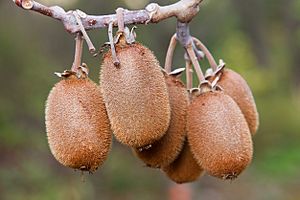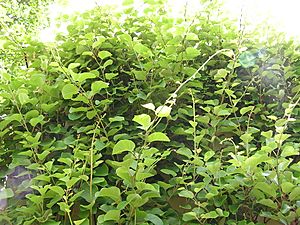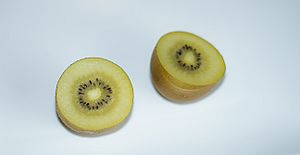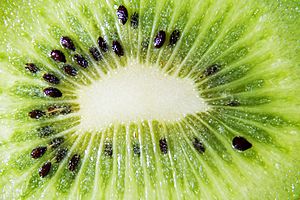Actinidia chinensis facts for kids
Quick facts for kids Actinidia chinensis |
|
|---|---|
 |
|
| Fruit | |
 |
|
| Foliage | |
| Scientific classification | |
| Genus: |
Actinidia
|
| Species: |
chinensis
|
Actinidia chinensis is a plant that grows like a vine and produces fruit. It's usually called the golden kiwifruit in stores. This plant comes from China.
It belongs to a group of plants called Actinidia, which has about 40 different types. The golden kiwifruit is a close relative of the regular green kiwifruit (Actinidia deliciosa). The fruit can be green, light green, or gold, depending on how it was grown and developed by plant scientists.
Contents
About Golden Kiwifruit
Golden kiwifruit has smooth, bronze-colored skin. It often has a small beak-like shape where it connects to the stem. The inside of the fruit can be bright green or a clear, bright yellow.
This type of kiwifruit is usually sweeter and smells nicer than the common green kiwifruit. Its taste is often compared to other sweet fruits from warm places. Some golden kiwifruits are very special because they have a red ring around the center of the yellow fruit.
Because golden kiwifruit has less fuzzy skin than green kiwifruit, many people find it easier to eat without peeling. This makes it a popular choice.
Popular Types of Golden Kiwifruit
'Hort16A' was a very popular type of golden kiwifruit sold worldwide. It was first known as Zespri Gold. However, between 2010 and 2013, many of these plants in New Zealand got sick from a germ called PSA bacterium.
After that, a new type of golden kiwifruit called 'Zesy002' was found. This new type was much better at fighting off the disease. So, most farmers switched to growing 'Zesy002', which is now sold as SunGold. People around the world continue to love this new golden kiwifruit.
Where Golden Kiwifruit Grows
In its natural home in China, Actinidia chinensis grows in thick bushes and forests. It likes to grow in forests with oak trees and in lighter woods. You can also find it in ravines and on slopes. It prefers places that are about 200 to 230 meters (about 650-750 feet) above sea level.
If you grow it in a garden outside of China, it can spread very wide, up to 9 meters (30 feet) in all directions. This means it needs a lot of space unless you trim it back often.
History and Farming
The golden kiwifruit plant originally comes from the Hubei or Sichuan areas of China. It was first brought to New Zealand in 1904. In China, you can find Actinidia chinensis growing all over the southeast part of the country.
New Zealand was the first country to start growing it for sale. They also developed the common green kiwifruit, Actinidia deliciosa, there.
A British plant explorer named Robert Fortune sent dried plant samples (called herbarium specimens) to the Royal Horticultural Society. From these samples, a scientist named Jules Émile Planchon gave the plant its scientific name in 1847. Later, in 1900, another explorer named E.H. Wilson sent seeds from China to a plant nursery, which helped introduce the plant to Western gardens.
Uses of Golden Kiwifruit
The fruits of Actinidia chinensis are about the size of a chicken egg. They are good to eat and are full of healthy things. They are a great source of vitamin C and dietary fiber, which helps your body stay healthy.
See also
 In Spanish: Actinidia chinensis para niños
In Spanish: Actinidia chinensis para niños




